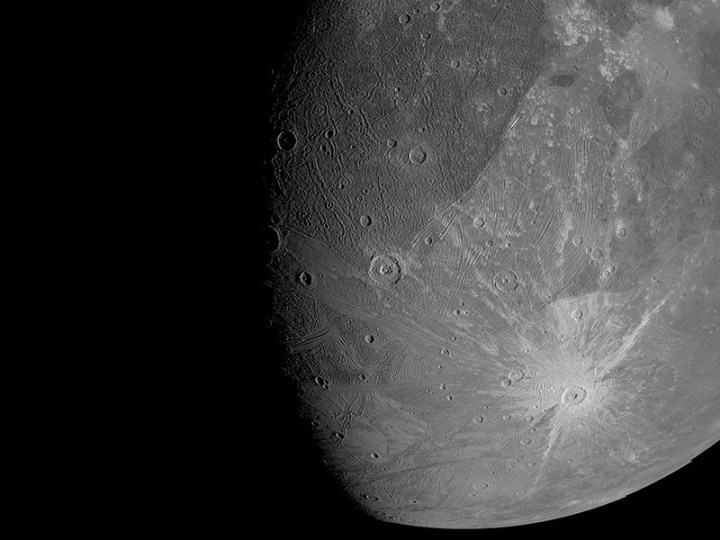
NASA’s Juno spacecraft this week beamed back an exquisite image (above) of Ganymede, the largest moon in our solar system.
The image of one of Jupiter’s many moons was captured on June 7 during the closest flyby of Ganymede since Galileo passed by in 2000.
Taken by Juno’s JunoCam imager, it shows the water-ice-encrusted moon in astonishing detail, including numerous craters and a grooved terrain that in places is as high as 700 meters (2,300 feet) and possibly linked to tectonic faults.
Another image (right), this time captured by Juno’s Stellar Reference Unit star camera, offers an even closer view of the moon’s surface. This image is actually of Ganymede’s “dark side” (the side opposite to the sun), though sunlight reflecting off Jupiter made the capture possible.

“This is the closest any spacecraft has come to this mammoth moon in a generation,” said Juno Principal Investigator Scott Bolton of the Southwest Research Institute in San Antonio. “We are going to take our time before we draw any scientific conclusions, but until then we can simply marvel at this celestial wonder.”
Dark side of the moon
“The conditions in which we collected the dark side image of Ganymede were ideal for a low-light camera like our Stellar Reference Unit,” said Heidi Becker, Juno’s radiation monitoring investigation lead at NASA’s Jet Propulsion Laboratory. “So this is a different part of the surface than seen by JunoCam in direct sunlight. It will be fun to see what the two teams can piece together.”
The space agency is aiming to use data from Juno to learn more about Ganymede’s composition, ionosphere, magnetosphere, and ice shell. The spacecraft is also gathering measurements of the radiation environment that could assist future missions to Jupiter and its moons, of which there are believed to be around 79.
Bolton said Juno, which reached Jupiter in 2016 after launching from Earth five years earlier, has with it a suite of scientific instruments that can examine Ganymede “in ways never before possible,” adding that the spacecraft’s ability to get so close “brings the exploration of Ganymede into the 21st century.”
Ganymede is the only moon with a magnetic field, which is known to cause auroras. The Hubble Space Telescope found evidence of a thin oxygen atmosphere on Ganymede in 1996, though it’s far too thin to support life as we know it, NASA said.
A tantalizing prospect is NASA’s promise of a color portrait of Ganymede comprising images taken by Juno on its latest flyby. The space agency is just waiting to gather all the data from Juno, which is currently around 435 million miles (700 million km) from Earth.


